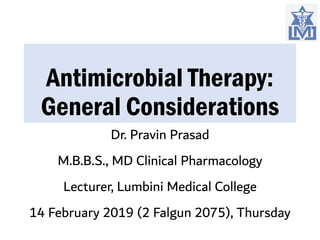
Antimicrobial therapy-General consideration
- 1. Antimicrobial Therapy: General Considerations Dr. Pravin Prasad M.B.B.S., MD Clinical Pharmacology Lecturer, Lumbini Medical College 14 February 2019 (2 Falgun 2075), Thursday
- 2. By the end of the class, BSN 1st Year students will be able to: ➢Differentiate the terms antibiotic and antimicrobial agents (AMAs) ➢Understand the basis of classification of AMAs ➢List the factors governing choice of AMA ➢Explain the rationale of combining AMAs ➢Identify the conditions requiring prophylactic use of AMAs ➢List the adverse effects and causes of failure of AMA therapy
- 3. Differentiating the terms ➢Antibiotics: ✓Substances produced by micro- organisms, which selectively supress the growth or kill the micro-organisms at very low concentrations ➢Antimicrobial agents: ✓Synthetic as well as naturally obtained drug that attenuate microorganisms
- 4. Basis of classification of AMAs ➢Type of organism against which primarily active ✓Antibacterial, antifungal, antiviral, antiprotozoal, anthelminthic ➢Spectrum of activity ✓Narrow spectrum, Broad spectrum ➢Type of action ✓Primarily bacteriostatic or bactericidal
- 5. Basis of classification of AMAs ➢Mechanism of Action: ✓Inhibit cell wall synthesis ✓Cause leakage from cell membranes ✓Inhibit protein synthesis ✓Cause misreading of m-RNA code and affect permeability ✓Inhibit DNA gyrase ✓Interfere with DNA Function ✓Interfere with DNA function ✓Interfere with intermediary metabolism
- 6. Choice of an Antimicrobial Agent Organism related Drug related Patient related
- 7. Patient Factors affecting the choice of an Antimicrobial Agent ➢Age ➢Renal or Hepatic Function ➢Local factors ➢Drug Allergy ➢Impaired Host Defence ➢Pregnancy ➢Genetic Factors
- 8. Patient Factors affecting the choice of an Antimicrobial Agent ➢Age ✓Chloramphenicol in new born-grey baby syndrome ✓Tetracycline are C/I in children below 6 years ✓Half life of aminoglycosides is prolonged in the elderly ➢Pregnancy ✓All antibiotics pose risk to the fetus when used in pregnancy. Penicillins, most cephalosporins and macrolides appear safe. ➢Impaired host defence ✓Bactericidal drugs are must in immunocompromised patients.
- 9. Patient Factors affecting the choice of an Antimicrobial Agent ➢4.Renal failure Drugs Contraindicated Dose reduction required in renal failure Cephalothin Aminoglycosides Cephaloridine Amphotericin B Nitrofurantoin Vancomycin Nalidixic Acid Ethambutol Tetracyclines (Except Doxycycline) Penicillin, Rifampicin: No Dose Adjustment Required
- 10. Patient Factors affecting the choice of an Antimicrobial Agent ➢Liver function Drugs C/I in liver disease Dose reduction required in liver failure Erythromycin estolate Chloramphenicol Tetracyclines Isoniazid Pyrazinamide Rifampicin Pefloxacin Clindamycin
- 11. Patient Factors affecting the choice of an Antimicrobial Agent ➢Genetic Factors: ✓Antimicrobials producing hemolysis in G6PD deficient patients are: • Primaquine, Chloroquine, Quinine • Dapsone, Sulphonamides • Chloramphenicol, Nitrofurantoin, Fluoroquinolones,
- 12. Choice of an Antimicrobial Agent: Organism Related Considerations ➢Clinical Diagnosis itself directs the choice of the AMA ➢A good guess can be made ➢Choice based on bacteriological examination ✓Bacterial services are not available ✓Bacterial services are available but treatment cannot be delayed: Emperical Therapy ✓Bacterial services are available and treatment can be delayed
- 13. Choice of an Antimicrobial Agent: Organism Related Considerations ➢Emperical Therapy: ✓Refers to initiation of antibiotics depending upon knowledge and experience of physician before result of culture and sensitivity test is available ✓Broad spectrum antibiotics started ✓After sending sample for C/S • In serious infections like meningitis & septicaemia
- 14. Choice of an Antimicrobial Agent: Drug Factors ➢Spectrum of activity ➢Type of activity ➢Sensitivity of organism ➢Relative toxicity ➢Pharmacokinetic profile ➢Route of administration ➢Evidence of clinical efficacy
- 15. Combined Use of Antimicrobial Agents ➢To achieve synergism ➢To reduce severity of adverse effects ➢To prevent emergence of resistance ➢To broaden the spectrum of antimicrobial action ➢Disadvantages??
- 16. Combined Use of Antibiotics ➢Two bacteriostatic agents: additive effect ✓Clavulanic acid with amoxicillin. ➢Two bactericidal agents: additive ✓Penicillin and Aminoglycosides Static Cidal Static Additive ? Cidal ? Additive
- 17. Combined Use of Antibiotics ➢Combination of a bactericidal with a bacteriostatic drug: ✓Additive if the organism has low sensitivity to the cidal drug • Streptomycin + Tetracycline for brucellosis ✓Antagonistic if the organism has high sensitivity to cidal drug • Penicillin + tetracycline for pneumococci.
- 18. Prophylactic Use of Antimicrobials ➢Use of AMAs before the clinical disease has occurred ✓Prevent the setting in of an infection ✓Suppress contacted infections
- 19. Prophylactic Use of Antimicrobials Type of Prophylaxis Example Prophylaxis against specific organisms Rheumatic fever (Penicillin G) Prevention of infection in high risk situations Malaria (Chloroquine) Prevention of infection in general Prior to surgical procedures
- 20. Problems that arise with use of AMAs ➢Toxicity ✓Local irritancy ✓Systemic toxicity ➢Hypersensitivity reactions ➢Superinfection ➢Drug Resistance ✓Natural ✓Acquired ➢Nutritional deficiencies ➢Masking of an infection
- 21. Mechanism of Resistance ➢Decrease affinity for the target ✓Pneumococci, Staphylococci: Altered penicillin binding proteins ➢Development of alternative metabolic pathway ✓Sulfonamides resistant organisms start utilizing performed folic acid in place of synthesizing it from PABA. ➢Drug resistance by inactivating enzymes ✓Aminoglycosides, Beta-lactams, Chloramphenicol ➢Development of efflux pumps ✓Tetracyclines, Erythromycin, Fluoroquinolones
- 22. Superinfection (Suprainfection) ➢A new infection occurring in a patient having a pre- existing infection ➢Most difficult to treat
- 23. Failure of AMA Therapy ➢Causes ✓Improper selection of drug, route, dose or duration of treatment ✓Delayed commencement of treatment ✓Poor host defense eg; Neutropenia, Leukemia ✓Failure to take necessary adjuvant measures • Drainage of abscess, removal of renal stone or other foreign bodies, control of DM
- 24. Conclusion ➢Antibiotics are naturally obtained from micro- organisms ➢Classification of AMAs can be done on different basis ✓Based on mechanism of action important ➢Choice of AMA depends on patient related, organism related and drug related factors
- 25. Conclusion ➢AMAs can be combined for multiple advantages ➢AMA prophylaxis is started before the clinical manifestation of disease has occurred ➢Drug resistance is one of the dreadful complication of AMA ➢Failure of AMA therapy can occur due to some avoidable situations
- 26. Any queries? They are not the same
